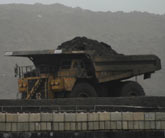 The largest oil sands mining trucks can carry 400 tonnes of oil sands per load. Photo: David Dodge, The Pembina Institute. |
Media ReleaseJul 25, 2007 Oil Sands Multistakeholder Committee Recommendations Fail to Address Runaway Pace of Oil Sands DevelopmentResponsibility Now Rests With Premier Stelmach's GovernmentMedia Contact: Dan Woynillowicz The recommendations of the Oil Sands Multistakeholder Committee released today by the Government of Alberta fail to address the main concerns of Albertans, according to the Pembina Institute. The final report was submitted to the Government of Alberta on June 30, 2007, and is currently being reviewed by the Ministers of Energy, Environment and Sustainable Resource Development. The Ministers have not yet responded to either the consensus or non-consensus recommendations of the committee. "The consensus recommendations of the committee fail to address Albertans' number one concern: the runaway pace of oil sands development. Now it's up to Premier Stelmach to tackle this concern head-on and make a decision about slowing the pace of development," noted Dan Woynillowicz, a Senior Policy Analyst with the Pembina Institute and one of three environmentalists on the committee. "Unfortunately some members of the committee were more interested in defending the status quo than in addressing the growing concerns that Albertans have about how oil sands development is occurring." The Pembina Institute's formal submission to the public consultation laid out a blueprint calling for a "pause" on new oil sands project approvals and lease sales until the Government of Alberta addresses six key requirements for responsible development (see Background below). In a recent poll of Albertans conducted by Probe Research for the Pembina Institute it was found that 71 per cent of Albertans believe that the Government of Alberta should suspend new oil sands approvals until infrastructure and environmental management issues have been addressed in areas affected by oil sands development. In addition, 74 per cent of Albertans believe that the government should manage the rate of oil sands development to meet the best long-term interests of Albertans. That compares to only 20 per cent who believe that market forces should decide the rate of oil sands development in Alberta. "Albertans have made it clear that they aren't willing to write-off the environment for oil sands development," said Woynillowicz. "While some progress was made by the committee in making consensus recommendations regarding some of the environmental impacts arising from oil sands development, the majority are simply 'band aid' solutions. Ultimately these recommendations still fail to address the cumulative threats that oil sands development pose to our boreal forest, fresh water, air quality and climate." -30- For more information: Oil Sands Fever - A Blueprint for Delivering on Albertans' Expectations can be downloaded at http://www.oilsandswatch.org Dan Woynillowicz, Senior Policy Analyst Background The Pembina Institute's Blueprint for Responsible Oil Sands Development outlines six key elements that serve as the basis for such a plan. These elements include:
|
|




